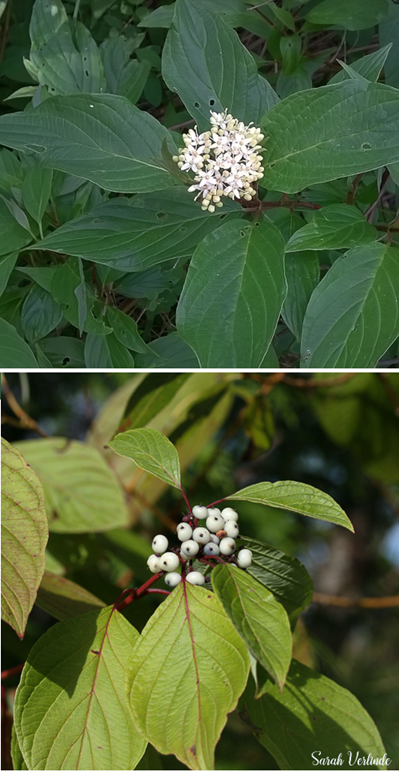Red-osier dogwood
Cornus stolonifera – Red-osier dogwood
Formerly Cornus sericea ssp. sericea
Morphology

- Family: Cornaceae
- Plant Type: deciduous upright/spreading shrub
- Height: 4-18 feet tall
- Leaves: oval to elliptical shape with pointed (acuminate) tips and a smooth margin. The veins appear to be parallel, although they branch at the very edges near the margin. Oppositely arranged. Colors can vary from bright green, leathery green to burgundy in the fall.
- Notable feature: bark, especially on newer growth and during the winter, can have a very bright red color.
Distribution and Habitat
Habitat: Riparian zones where a river or stream is nearby for adequate moisture or wetlands. Can tolerate partially dry areas. Full sun to partial shade.
Reproduction
- Flower color: White to cream flowers in a round flat-top cluster, turning into white-light blue round berries.
- Flowering Season: May-July
- Generation: Perennial
Restoration and Conservation Applications
Red osier-dogwood is an excellent plant for restoration purposes. It is easy to propagate, grows quickly, and has wildlife value. It does well in areas that are seasonally inundated with water. Places along stream banks and shorelines are ideal. It has a fibrous root system which is great for soil stabilization. This dogwood is an excellent shrub to plant along sunny edges and in deciduous canopy shade because it is sun-loving and shade tolerant. It provides ample shade on the ground below and nearby, which is serves well to shade out weedy species like reed canarygrass and Himalayan blackberry. The flowers in spring provide nectar for insects and hummingbirds. Birds eat the berries that develop in summer and early fall, as well as nest in the protective shrub cover.
Ethnobotany
The beautiful slender red stems are used for basket weaving by Native American tribes. The twigs were used for all sorts of functions including salmon spreaders and medicinal uses. On the west coast, native tribes made tea from the bark for medicinal purposes. Parts of the plant were used by native tribes to produce black, red, and khacki dyes. Berries were also dried and eaten.
References and Resources
- Pojar, J and MacKinnon, A. 2004. Plants of the Pacific Northwest Coast: Washington, Oregon, British Columbia and Alaska. Vancouver (BC): Lone Pine Publishing.
- Turner, NJ and Efrat, BS. 1982 Ethnobotany of the Hesquiat Indians of Vancouver Island. Victoria (BC): British Columbia Provincial Museum (p. 73).
- USDA Plant Fact Sheet: Red osier dogwood [Internet]. c2006 [cited 2014 Dec 07]. Available from: http://plants.usda.gov/plantguide/pdf/cs_cose16.pdf
- WTU Image Herbarium: http://biology.burke.washington.edu/herbarium/imagecollection/browse.php?Genus=Cornus
This article was written by Sarah Verlinde. For questions regarding the UWB/CC Plant Tour, contact Sarah at severlin@uw.edu.
